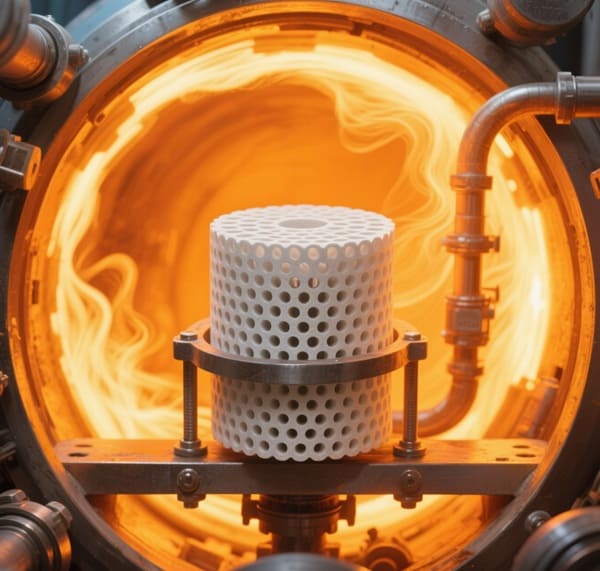How Does YSZ Perform in High-Temperature Environments?
Yttria-Stabilized Zirconia (YSZ) is one of the most important ceramic materials for extreme temperature environments due to its superior thermal insulation, phase stability, and resistance to chemical and mechanical degradation. It plays a critical role in industries such as aerospace, energy, and advanced manufacturing, where materials must withstand temperatures exceeding 1,200°C without losing structural integrity. This article explores the high-temperature performance of YSZ, how it compares to other ceramics, its key mechanical and thermal properties, and the latest trends in its application. For engineers designing thermal barrier systems or solid oxide fuel cells, understanding YSZ’s behavior is essential.
At Advanced Ceramic Hub, we specialize in high-quality YSZ ceramic products, ensuring optimal performance for industrial and scientific applications.

What Is YSZ and Why Use It?
YSZ is zirconium oxide (ZrO₂) stabilized with 3–8 mol% yttria (Y₂O₃). This stabilizer maintains the high-temperature cubic or tetragonal crystal phases at room temperature, preventing cracks due to monoclinic phase shrinkage. Its high melting point (~2,700 °C), low thermal conductivity (~2 W/m·K at 800 °C), and strong phase resilience make YSZ ideal for coatings and components in high-temperature environments.
YSZ Basic Properties:
| Property | Value |
| Thermal Expansion (α) | 10.5 ×10⁻⁶/K at 20–800 °C |
| Thermal Conductivity | 2–3 W/m·K at 800 °C |
| Melting Point | ~2,700 °C |
| Phase Stability | Cubic/Tetragonal to ~2,400 °C |
| Density | 6.05 g/cm³ |
YSZ’s properties are finely balanced, offering both mechanical strength and thermal insulation, making it a top choice for extreme conditions.
Explore our high-quality YSZ ceramic products.
What Are YSZ’s High-Temperature Mechanical Properties?
YSZ maintains strong mechanical performance across a wide temperature range. Its flexural strength (~800 MPa) at room temperature decreases to ~200 MPa at 1,200 °C, while fracture toughness improves slightly to about 3–4 MPa·m¹/². Creep resistance remains reasonable up to 1,400 °C under moderate loads, positioning YSZ as a durable option for sustained high-temperature use.
Mechanical Properties vs Temperature:
| Temperature (°C) | Flexural Strength (MPa) | Fracture Toughness (MPa·m¹/²) |
| Room (25°C) | ~800 | 3.0 |
| 600 °C | ~600 | 3.5 |
| 1,200 °C | ~200 | 4.0 |
| 1,400 °C | ~100 (with small creep) | 4.2 |
YSZ’s ability to retain toughness at high temperatures makes it suitable for thermally stressed components such as turbine blades or combustor liners.
How Does YSZ Perform Under Thermal Cycling and Shock?
One of YSZ’s strengths lies in its defense against thermal shock, thanks to its low thermal conductivity and phase transformation behavior. Many coatings sustain over 10,000 cycles from 1,100 °C to 200 °C without cracking, while dense bulk YSZ pieces typically endure ΔT > 500 °C.
Typical Thermal Cycling Applications:
- Thermal barrier coatings on turbine blades
- Aerospace hot-section components
- Gas furnace and kiln linings
This resilience ensures durability when components repeatedly heat and cool in rapid succession.
Where Is YSZ Used in Extreme-Temperature Applications?
Yttria-stabilized zirconia (YSZ) plays a critical role in many high-temperature industries due to its rare ability to maintain structural integrity, thermal insulation, and chemical stability above 1,200 °C. Its exceptional resistance to thermal shock, oxidation, and phase transformation enables it to outperform many traditional ceramics in both surface coatings and bulk structural components. These attributes make YSZ indispensable in sectors where failure at high temperatures can result in costly downtime, system failure, or safety hazards.
Key High-Temperature Applications of YSZ:
| Application Area | Specific Role of YSZ |
| Gas turbines | Used as thermal barrier coatings (TBCs) on turbine blades and vanes to protect from combustion heat and reduce cooling needs |
| Solid oxide fuel cells (SOFCs) | Serves as the solid electrolyte and interconnect material, enabling efficient ion conduction at high operating temperatures (~800–1,000 °C) |
| Jet engines | Applied in hot-section components such as seals, combustors, and nozzle guides for thermal protection and oxidation resistance |
| Laser optics and mirrors | Functions as a substrate material with high thermal stability and low expansion for use in high-power laser environments |
| Concentrated solar power (CSP) systems | Used as a refractory material for solar receivers and insulation components exposed to direct solar flux and temperatures above 1,000 °C |
By leveraging these applications, YSZ ensures longer service life, improved system efficiency, and reduced energy loss in extreme heat conditions. Its high-temperature stability and versatility continue to expand its role in next-generation thermal technologies.
How Does YSZ Compare to Other High-Temperature Ceramics?
YSZ performs uniquely compared to a wide range of high-temperature ceramics used in engineering. Each material offers a different balance of thermal resistance, toughness, and insulation. This extended comparison helps clarify why YSZ remains a preferred choice for many extreme-temperature applications.
Comprehensive Thermal-Ceramic Performance Comparison:
| Material | Max Temp (°C) | Thermal Conductivity (W/m·K) | Fracture Toughness (MPa·m¹⁄²) | Density (g/cm³) | Thermal Shock Resistance |
| YSZ | ~1,400 | 2–3 | 6–10 | 6.05 | Excellent |
| Alumina (Al₂O₃) | ~1,500 | 20–30 | 3–4 | 3.95 | Moderate |
| Silicon Carbide (SiC) | ~1,600 | 100–130 | 4–6 | 3.2 | Low–Moderate |
| Hafnia (HfO₂) | ~2,000 | 1.5–2.5 | 2–3 | 9.68 | Excellent |
| Mullite (3Al₂O₃·2SiO₂) | ~1,600 | 3–5 | 4–5 | 3.1 | Good |
| Magnesium Oxide (MgO) | ~2,800 | 40–50 | 3–4 | 3.58 | Moderate–Good |
| Aluminum Nitride (AlN) | ~1,700 | 170–200 | 2–3 | 3.26 | Moderate |
| Silicon Nitride (Si₃N₄) | ~1,400 | 20–30 | 7–10 | 3.2 | High |
Key Insights:
- YSZ stands out for low conductivity and high toughness—a rare combination essential for thermal barrier coatings.
- Alumina is economically and thermally resistant but more prone to cracking under shock.
- SiC offers excellent mechanical strength but poor insulation due to high conductivity.
- HfO₂ withstands the highest temperatures but is dense, brittle, and costly.
- Mullite offers a mid-range compromise, used where moderate thermal insulation with better shock resistance is needed.
- MgO and AlN are used where high temperatures and specialty properties (like conductivity or corrosion resistance) are required.
- Si₃N₄ rivals YSZ in toughness and shock resistance but has higher conductivity, making it less ideal for insulation.
Overall, YSZ emerges as the balanced choice for applications demanding low heat transfer, strong fracture resistance, and excellent thermal-shock resilience.
Request a custom quote for the YSZ ceramic product.
What Are the Design Considerations for YSZ Parts?
Designing YSZ components requires attention to several factors:
Key Design Guidelines:
- Thickness: ≤ 300 μm for coatings to reduce cracking risk
- Bond Coat Compatibility: Must match thermal expansion
- Grain Size: Fine (<5 μm) for strength and stability
- Geometry: Avoid sharp corners that concentrate stress
- Surface Finish: A Smooth finish reduces crack initiation
Proper design—alongside controlled sintering and bonding—ensures long-lasting performance.
What Are the Limitations and Trade-Offs of YSZ?
YSZ does have trade-offs to consider:
- Cost: Higher than alumina or SiC
- Machining Difficulty: Hard and brittle—best processed as powders
- Phase Volume Change: A Slight tetragonal to monoclinic transformation around 1,000 °C may stress the material
- Creep Resistance: Limited under sustained high-load conditions
Despite these limitations, YSZ’s benefits often outweigh the drawbacks in high-temperature applications.
What Is the Future of YSZ in High-Temperature Systems?
YSZ’s future in high-temperature engineering is closely tied to innovations in coatings, composite ceramics, and advanced manufacturing. As demands rise in aerospace, energy, and fuel cell applications, YSZ continues to evolve with improved durability and adaptability. Researchers are exploring gradient coatings, nanostructures, and additive manufacturing to boost performance and thermal reliability.
Emerging Trends:
- Nanostructured thermal barrier coatings for longer lifespan
- Gradient YSZ layers to reduce thermal mismatch
- 3D-printed YSZ for complex geometries
- Composite blends like YSZ + SiC for hybrid performance
- Layered membranes in SOFC and CSP systems
These trends will reinforce YSZ’s critical role in the next generation of high-efficiency systems.
FAQ
| Question | Answer |
| How long do YSZ coatings last in turbine applications? | 5–15 years, depending on temperature cycling and bond coat integrity |
| Can YSZ crack from abrupt temperature changes? | Unlikely—most designs survive ΔT > 500 °C due to thermal resistance |
| Is YSZ electrically insulating? | Yes, even at high temperature (dielectric ~10⁸–10⁹ Ω·cm at 800 °C) |
| Can YSZ be machined like metals? | No—it’s best applied as coatings or produced through ceramic forming |
| Are there alternatives with higher strength? | CMCs or SiC are stronger but lack YSZ’s thermal insulation capability |
Conclusion
YSZ excels under extreme heat due to its combination of phase stability, low thermal conductivity, and moderate toughness. These traits have earned it vital roles in turbine coatings, fuel cells, jet engines, and solar power systems. Although cost and brittleness pose challenges, evolving materials science and manufacturing techniques continue to enhance YSZ’s performance and applicability. For engineers and designers seeking reliable high-temperature solutions, YSZ remains a key material. Advanced Ceramic Hub offers premium YSZ powders, coatings, and design guidance to support next-generation thermal systems.
Looking for high-quality YSZ ceramic products? Contact us today!
